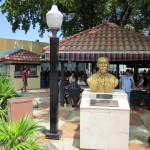As rising property prices and a shrinking supply of land drive developers west, Miami’s Little Havana has attracted renewed attention from those looking to duplicate the success of neighborhoods like Brickell.
Little Havana saw scattered interest during the years leading up to the real estate bust, but most of those projects fell apart. Morrison, a 395-unit development once considered the biggest condominium project proposed for Little Havana, was the most notable plan to fizzle out during the bust.
But that was then. Now that the market has recovered and a bevy of new projects are underway in Miami’s most popular areas, firms like the Astor Companies are banking on land prices in Little Havana that haven’t caught up to the premiums of Brickell or Miami Beach.
Astor recently started construction on InTown, a mixed-use development that will house 312 condos between two 14-story towers, along with eight townhomes and 18,000 square feet of ground-floor retail. Construction for InTown, at 1940 Southwest Eighth Street, is expected to finish by the end of 2016.

Henry Torres, founder of the Astor Companies
Henry Torres, founder of Astor, told The Real Deal during a tour of the construction site that the company is marketing its units as “affordable luxury.”
The intent, he said, is to give young professionals another option besides Brickell, where rental price have greatly appreciated.
“I truly believe in Little Havana,” he said. “The neighborhood had a bad stigma 10 years ago. That’s not this neighborhood today.”
The project marks Astor’s second foray into the neighborhood, after Brickell Vista at 900 Southwest 8th Street. That development was completed in 2005 and sold out before the bust.
Torres said other developers have begun purchasing properties in the area, and he expects property prices to climb. A Brooklyn-based investment firm just picked up the recently built Miramar Apartments at 1023 Southwest 6th Street, and Torres himself is in preliminary talks with the owners of the popular Ball & Chain lounge about possibly buying more land in the neighborhood. The Chetrit Group is proposing a massive project nearby with four 60-story towers along the Miami River, and an investment group paid $5.3 million for a portfolio of apartment buildings in the neighborhood earlier this year.
But not everyone is welcoming the change. An initiative led by the city of Miami to upzone the area and entice development has met stiff criticism from preservationists, who argue that blanketing the area in high-rises would destroy one of Miami’s most important landmarks.
Their efforts helped establish the “Riverview Historic District” earlier this year, which now protects a few square blocks of East Little Havana that housed Latin American refugees and immigrants who came to the United States during the first half of the 20th century.
Daniel Ciraldo, a member of the Miami Design Preservation League, told TRD that a balance must be struck between revitalizing the neighborhood, which has pockets of run-down buildings, and protecting sites that are genuinely important to Miami’s history.
“There is a treasure trove of historic buildings in Little Havana,” he said. “What we need is first to survey the neighborhood and determine what those properties are.”

